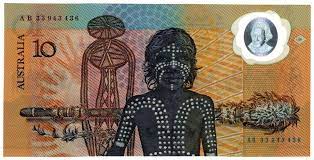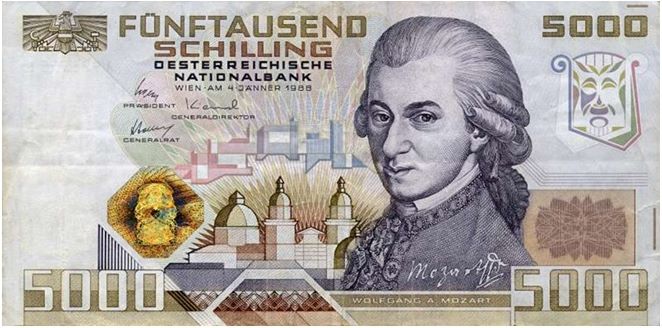



In the inaugural column of ‘Then and Now’ in June’s edition of Holography News®, which looked at the birth of automotive production model heads-up displays, I dropped in a tantalising snippet from the May 1988 edition of HN that chronicled the beginning of what has since become the single largest commercial application for holography of all time. In this edition, I will take up the story of holograms on banknotes by trawling through the recently digitised archives of HN and picking out the seminal moments in the sector’s growth.
The snippet in question reported that Australia had become the first country to use a hologram on its currency. The country’s central bank issued a commemorative A$10 note made of biaxially orientated polypropylene (BOPP). This was the world’s first polymer banknote and displayed a computer-generated diffractive foil image of Captain Cook in a transparent window.
The feature was called Catpix™, a diffraction pattern created by blazing with an electron beam, developed by Australia’s Commonwealth Scientific and Industrial Research Organisation (CSIRO) Division of Chemical Physics. The Catpix technology was developed to overcome degradation of the diffractive image resulting from flexing or crumpling of the banknote during its lifetime.
In 1988 the Reserve Bank of Australia purchased the Catpix technology as part of the polymer banknote technology package.
In the following year, HN reported that the Austrian National Bank (ANB)had issued a 500 schilling note (approximately $380 in 1989), the first in the world to use Landis & Gyr’s (L&G’s) Kinegram® optical security device (HN November 1989). As the highest denomination note issued in Austria, it contained several anti-counterfeiting features, of which the Kinegram was the most readily identifiable by the public.
At the time, L&G described the Kinegram as a complex structure of strategically positioned, computer generated diffraction gratings creating an integrated dynamic optical movement. Using computer-aided design systems, the artwork could incorporate customer specified imagery. To the viewer, the effect was a colorful image which changes from different angles. According to L&G, the diffraction gratings, and therefore the changing imagery, could not be copied or reproduced without using its proprietary technology.
The Austrian Kinegram was mass produced by Leonard Kurz on hot-stamping foil, and L&G worked closely with the hot-stamping equipment company Gietz to ensure the reliability and accuracy of the embossing on a material optimised for banknote-quality paper. Extensive wear tests were conducted to demonstrate that the Kinegram would maintain its efficacy for the expected life of the note.
Although this was the first use of kinegrams on currency, the Federal Republic of Germany had been using them on visas and L&G was already in negotiations with several other national banks and passport offices.
The thinking behind the ANB’s decision to use the Kinegram on its banknotes was that as counterfeiting techniques were getting both more sophisticated and more accessible (ie. with the increasing availability of color photocopiers, laser scanners and ink-jet printers), it was crucial that this new high-value note should be well-protected.
The first reports of colour photocopiers being used to counterfeit banknotes came at Interpol’s 6th International Conference on Currency Counterfeiting (Madrid, 1977 1). The resolution, contrast and colour fidelity of the humble office copier had improved to the extent that casual counterfeiting of the printed features on a banknote was now a reality….and the security print industry had to react 2(see HN January 2022).
Strictly speaking, the first OVD (optically variable device) on the Australian note wasn’t a hologram (neither too was the Kinegram® on the Austrian schilling) because the diffractive fringes on the Australian note were totally computer-generated by CSIRO without any recourse to the phenomenon of interference, but to a wider, non-specialist audience, this is hair-splitting; hence the common use of ‘hologram’ to refer to all of these rainbow coloured foil features.

The Captain Cook image had no depth or parallax in any direction, but it does seem to flip from a positive to a negative – although not in a predictable way. Indeed, its main visual features were that it resembles a portrait of Captain Cook and its metallic surface glistens with iridescent colours when caught in the light. That was enough to dramatically distinguish it from a photocopy.
Following the Austrian 500 schilling, uptake of diffractive security features on banknotes was initially slow as many technical challenges, as well as the reluctance to accept DOVIDs (diffractive optically variable image devices) as secure features, had to be overcome.

The next significant development, in 1991, was the issue of the 20 markkaa from the Bank of Finland with a 2mm wide DOVID security thread using holographic film supplied by Applied Holographics. This development was followed shortly afterwards by the first diffractive stripe, which appeared on Bulgarian banknotes. By 2000, by which time the European Central Bank (ECB) had decided to use DOVID technology on the euro, 31 countries were issuing banknotes with DOVIDs, with a total of some 80 denominations in circulation.
The euro
The first series of euro banknotes featured kinegrams (mastered by OVD Kinegram, as L&G was now known and by then a part of KURZ) applied as stripes on the lower denominations (€5, €10 and €20) and Alphagrams™ (mastered by Hologram.Industries – then SURYS and now a part of IN Groupe) were applied as patches on the four higher denominations (€50, €100, €200 and €500).
The presence and quality of holograms on the euro confirmed that the age of diffractive anti-counterfeiting technology for banknotes had truly arrived, and in excess of 13 billion notes were issued in the first year alone, with every denomination featuring a DOVID.
There is no doubt that the showcasing of holograms on the euro came as a huge vote of confidence in the technology, paving the way for other central banks to adopt holograms as effective anti-counterfeiting solutions for their own new banknote programmes.
The second euro series, dubbed Europa, which went into circulation between 2013 and 2019 , also features DOVIDs on each denomination, this time all in the form of registered stripes. Euro banknotes are again facing a redesign by 2024 with a desire to make the currency ‘more relatable to Europeans of all ages and backgrounds’. There is a hope and expectation that DOVIDs will continue to feature in the new designs in a move from the ECB’s Governing Council to see innovative and secure banknotes that connect with people right across Europe.
As we look forward to a new age for the euro, one thing is clear: the role of holograms on banknotes as a cost-effective feature that the public recognise remains as strong as ever. The difficulty holograms present to criminals and counterfeiters cannot be overstated; indeed, a third of all current banknotes in circulation (327 and rising) now feature a DOVID. And that is why they will continue to be used by banknote issuing authorities for years to come.
The trend to bring origination capabilities in-house is set to increase as the innovation cycle time decreases and high security printers try to promote hybrid optical features (HOFs) as a way to get their technologies specified in tender documents for banknotes (see HN January 2023).
These HOFs, where different technologies engineer the surface and volume of a substrate, are not evidence of holography being ousted from its position as the premier optical anti-counterfeit technology, but as testament to its flexibility and the innovation of optical engineers.
Conversely, there is a feeling amongst some high security printers that the combination of movement, colour and dynamic shapes, whilst being eye-catching, is getting too complex for the public to authenticate with casual inspection. An alternative might be the return to ‘solid’ three-dimensional holograms – which is the route seemingly taken by the Bank of Japan for the newly designed 10,000, 5,000 and 1,000 yen notes (see HN May 2023).
The precise technology used for the image has not been confirmed, but the video 3 of a sample of a new 10,000-yen note being rotated about a vertical axis displays the hallmarks of a holographic stereogram. If it does, in fact, prove to be a holographic stereogram, this will signal a return to a technology that was used much earlier in the making of the ‘Shakespeare stereogram’, originated in Applied Holographics’ studios in Oxnard, California, and used to secure UK cheque guarantee cards (see HN Oct/Nov 1988).
Along with reports of the increasing interest in holograms as a security feature on banknotes in 1988/89 editions of HN, came a cautionary editorial noting that because of their growing success, there was a real need for the industry to improve its vigilance and policing of the creation and use of holograms as a counterfeiting deterrence.
An ‘open letter’ signed by Jeff Blyth, David Pizzanelli and Jonathan Ross called for the formation of an industry association partially for the purpose of performing this policing function. While industry reaction appeared to have been mixed toward this specific proposal, there was a general acceptance of the need to organise in order to protect the developing holographic security applications area.
It would be another five years before the industry overcame differences and the International Hologram Manufacturers Association (IHMA) was established, along with the Hologram Image Register, which has gone on to register more than 10,000 holographic images and underpin the use of holograms in authentication and security printing.
2 - https://estore.reconnaissance.net/product/diffractive-features-on-banknotes/